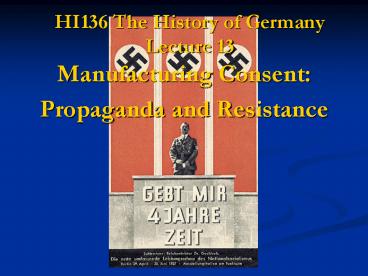HI136 The History of Germany Lecture 13 PowerPoint PPT Presentation
1 / 22
Title: HI136 The History of Germany Lecture 13
1
HI136 The History of GermanyLecture 13
- Manufacturing Consent
- Propaganda and Resistance
2
Economic Revival
- Respected financier Hjalmar Schacht appointed
President of the Reichsbank (1933-39) Minister
of Economics (1934-37) demonstrates the Nazis
need to keep big business on side. - Schacht given virtual dictatorial powers over the
economy. - Public works to get people back into employment.
- Sept. 1934 New Plan introduces state control
of trade currency exchange. Bilateral trade
agreements with South America and the Balkans. - By 1935 Germany had a trade surplus, unemployment
was down to 1.7 million and industrial output had
risen by 49.5
Hjalmar Schacht (1877-1970)
3
Public Works
- Reichsautobahnen
- Year km total
- 1935 108 108
- 1936 979 1087
- 1937 923 2010
- 1938 1036 3046
- 1939 255 3301
- 1940 436 3737
- 1941 90 3827
- 1942 34 3861
- 1943 35 3896
- Total 3896
4
Source John Hite Chris Hinton, Weimar and Nazi
Germany (2000)
5
Education and Youth
- Co-ordination of education system
- Politically unreliable teachers sacked.
- Curriculum brought into line with Nazi ideology.
- Youth Organizations
- Deutsches Jungvolk (German Young People, DJ)
Boys aged 10-14. - Hitler Jugend (Hitler Youth) Boys aged 14-18.
- Jungmädelbund (League of Young Girls) Girls
aged 10-14. - Bund Deutscher Mädel (League of German Girls,
BDM) Girls aged 14-18.
6
Work and Leisure
- Deutsche Arbeitsfront (DAF, German Labour Front).
- Kraft durch Freude (KdF, Strength through Joy).
- National Sozialistische Frauenschaft (NSF,
National Socialist Womanhood). - Deutsches Frauenwerk (German Womens Enterprise,
DFW).
7
- I view the first task of the new ministry of
Propaganda as being to establish co-ordination
between the Government and the whole people . . .
It is not enough for people to be more or less
reconciled to our regime, to be persuaded to
adopt a neutral attitude towards us, rather we
want to work on people until they have
capitulated to us, until they grasp ideologically
that what is happening in Germany today is not an
end in itself, but a means to an end. - Josef Goebbels, 15 March 1933
8
Themes
- Anti-Semitism
- Anti-Bolshevism
- Awakening of the German people
- Superiority of the Aryan race
- Mastery of Central Europe (Lebensraum)
- Volksgemeinschaft (Peoples community)
- Hitler myth
9
Broadcasting
- 1933 Reich Radio Company established a single
state broadcaster controlled by the government. - 1932 Only 25 of German households owned a
radio. - Volksempfänger (Peoples Receiver)
- By 1939 70 of German families have access to a
radio, and announcements broadcast by
loudspeakers in public places. - Radio Wardens make sure that people tune in to
Nazi propaganda.
10
The Press
- Control of the press harder to achieve.
- Germany had nearly 5,000 different daily
newspapers in 1933. - Eher Verlag (Nazi publisher) bought up papers
it owned 2/3 of the German press by 1939. - The Government controlled news stories at source
through the state news agency, DNB. - Editors Law (Oct. 1933) made editors
personally responsible for content.
The lounge at the German press club in Berlin,
with a picture of Hitler on the Wall.
11
(No Transcript)
12
The Nazi Calendar
- 30th January The Seizure of Power
- 24th February The refounding of the Party
(1925) - First Sunday in March Heroes Remembrance Day
- 20th April Hitlers Birthday
- 1st May National Day of Labour
- Second Sunday in May Mothering Sunday
- September Annual Nuremberg Party Rally
- 9th November Munich Putsch (1923)
13
(No Transcript)
14
(No Transcript)
15
Above Working Maidens by Leopold Schmultzer
(1940) Left Sculpture by Josef Thorak (1937)
16
Nazi Cinema
17
Opposition in the Third Reich (Sample)
- Organising a coup
- Attempting to assassinate Hitler and other
leaders - Going on strike
- Helping victims of Nazism
- Spying for foreign governments
- Deserting from the armed forces
- Committing suicide
- Emigrating
- Distributing anti-Nazi leaflets
- Underachieving in the workplace
- Publicly criticising the regime, telling
anti-Hitler jokes - Listening to American jazz and the BBC
- Not giving the Hitler greeting
- Refusing to join Nazi organisations
- Reading banned Nazi literature
18
George Elser (1903-1945)
Dietrich Bonhoeffer (1906-1945)
19
Hans Scholl (1918-1943)
Sophie Scholl (1921-1943)
20
Plots against Hitler, 1938-45
- May-September 1938 Army plot to depose Hitler.
- November 1939 George Esler attempts to
assassinate Hitler during the annual
commemoration of the 1923 Beer Hall Putsch. - 13 March 1943 Attempt to blow up Hitlers plane.
- March 1943-March 1944 Various military plots to
assassinate Hitler orchestrated by Colonel
Henning von Tresckow and General Friedrich
Olbricht. - 20 July 1944 Plot to kill Hitler with a bomb
planted in his military headquarters in East
Prussia.
21
Colonel Claus Schenck von Stauffenberg
(1907-1944), in real life (left) and as played
by Tom Cruise (right)
22
The Historiography of Resistance
- Ongoing debate on the nature, extent and
effectiveness of the resistance. - Used to legitimize post-war states
- East German historians presented Communist
resistance as the only anti-Fascist force in
Germany. - West German historiography concerned with
accusations of collective guilt presented
resistance as based on high moral and ethical
values, the individual standing up against
tyranny. - 1960s Hans Mommsen argued that
national-conservative resistance rooted in the
anti-democratic right of the 1920s. - 1970s Peter Hüttenberger Martin Broszat
resistance in everyday life. - Broszat Resistenz (immunity) people retain
their moral ethical values without actively
challenging the regime. - Mommsen Widerstandpraxis (Resistance Practice)
resistance was a process encompassing different
forms of dissent as individuals came to reject
the regime in its entirety. - Ian Kershaw Two approaches to the study of
resistance Fundamentalist (dealing with those
committed to the overthrow of the regime) and
Societal (dealing with dissent in everyday life).

